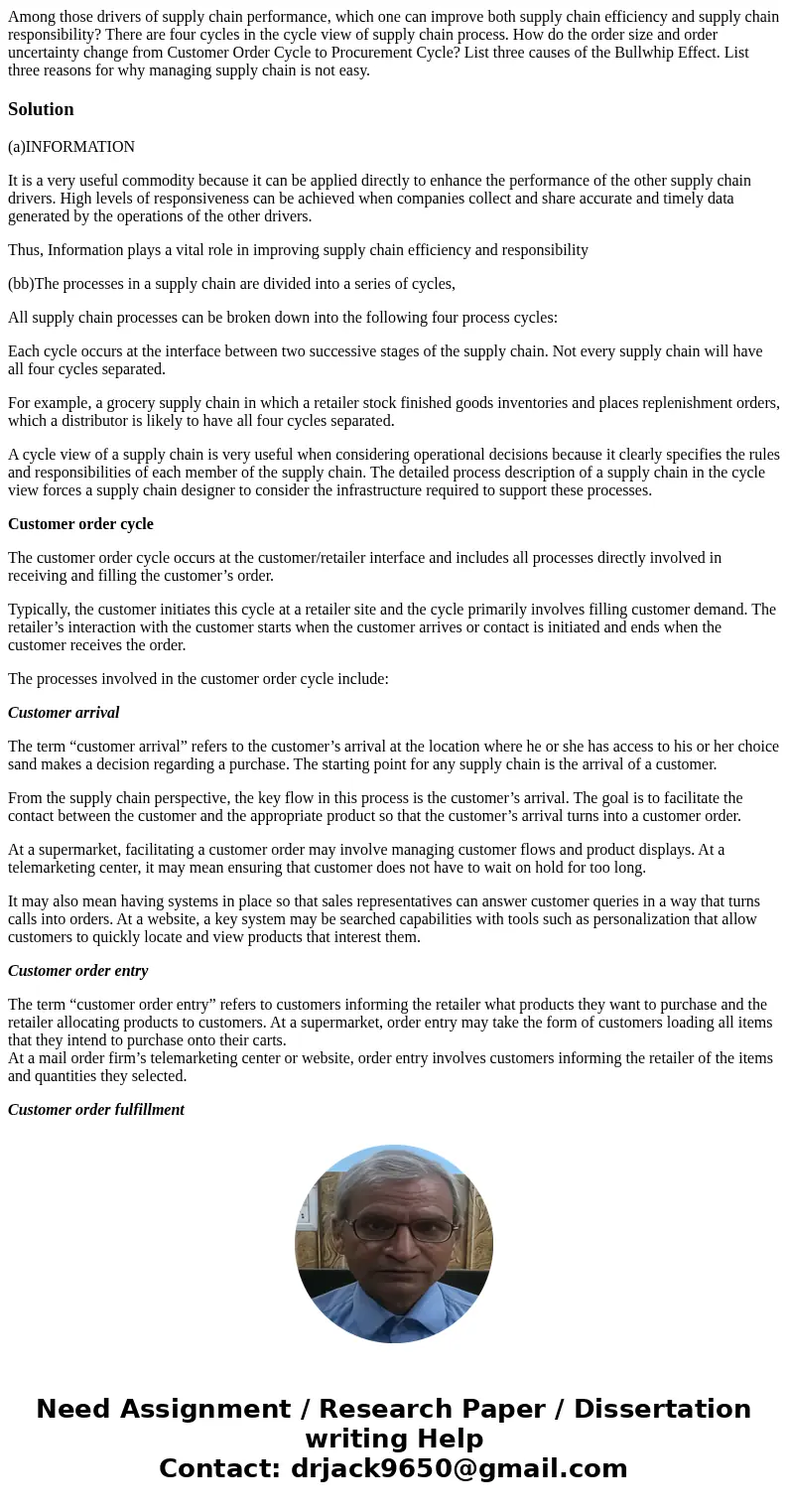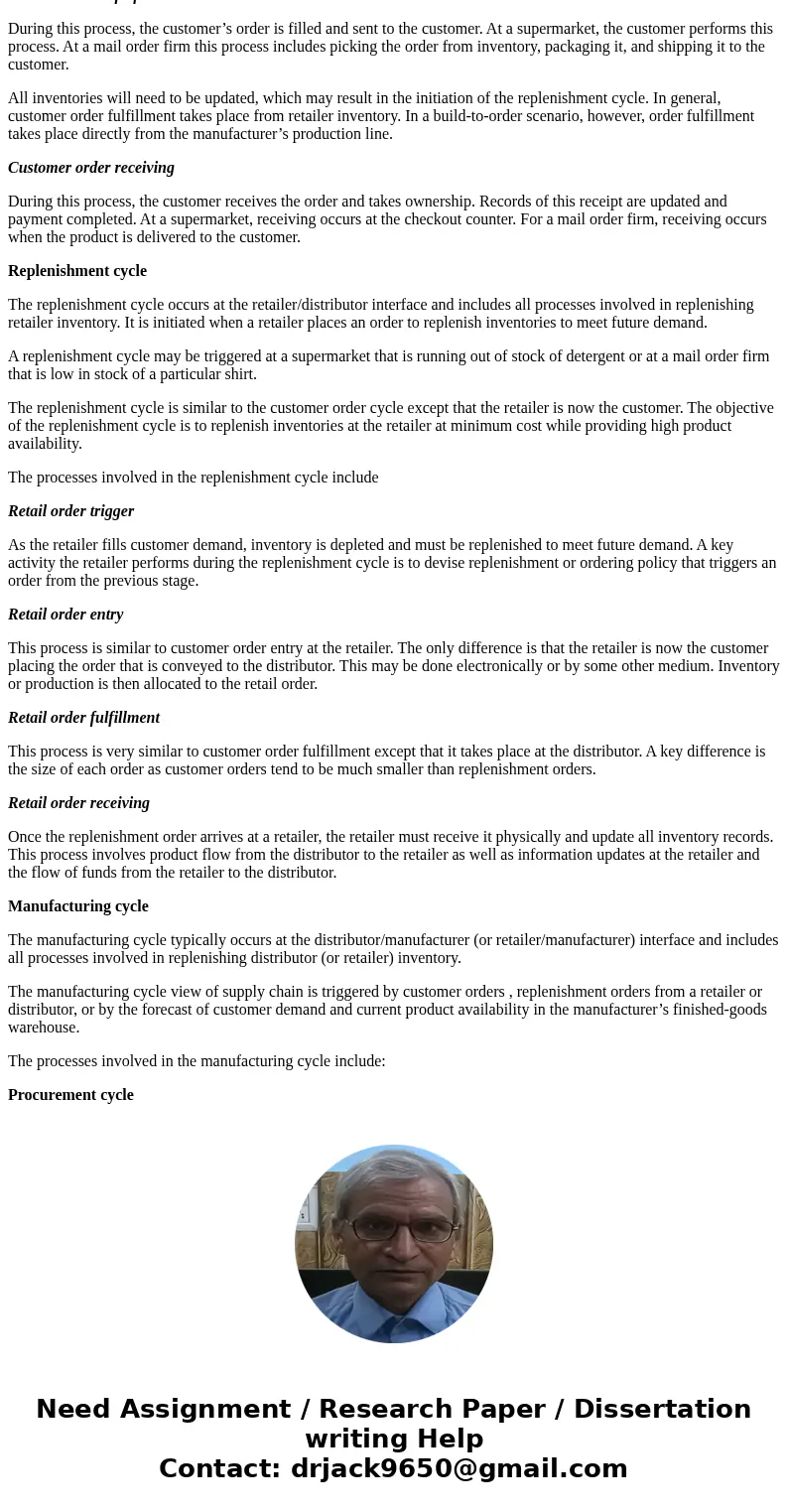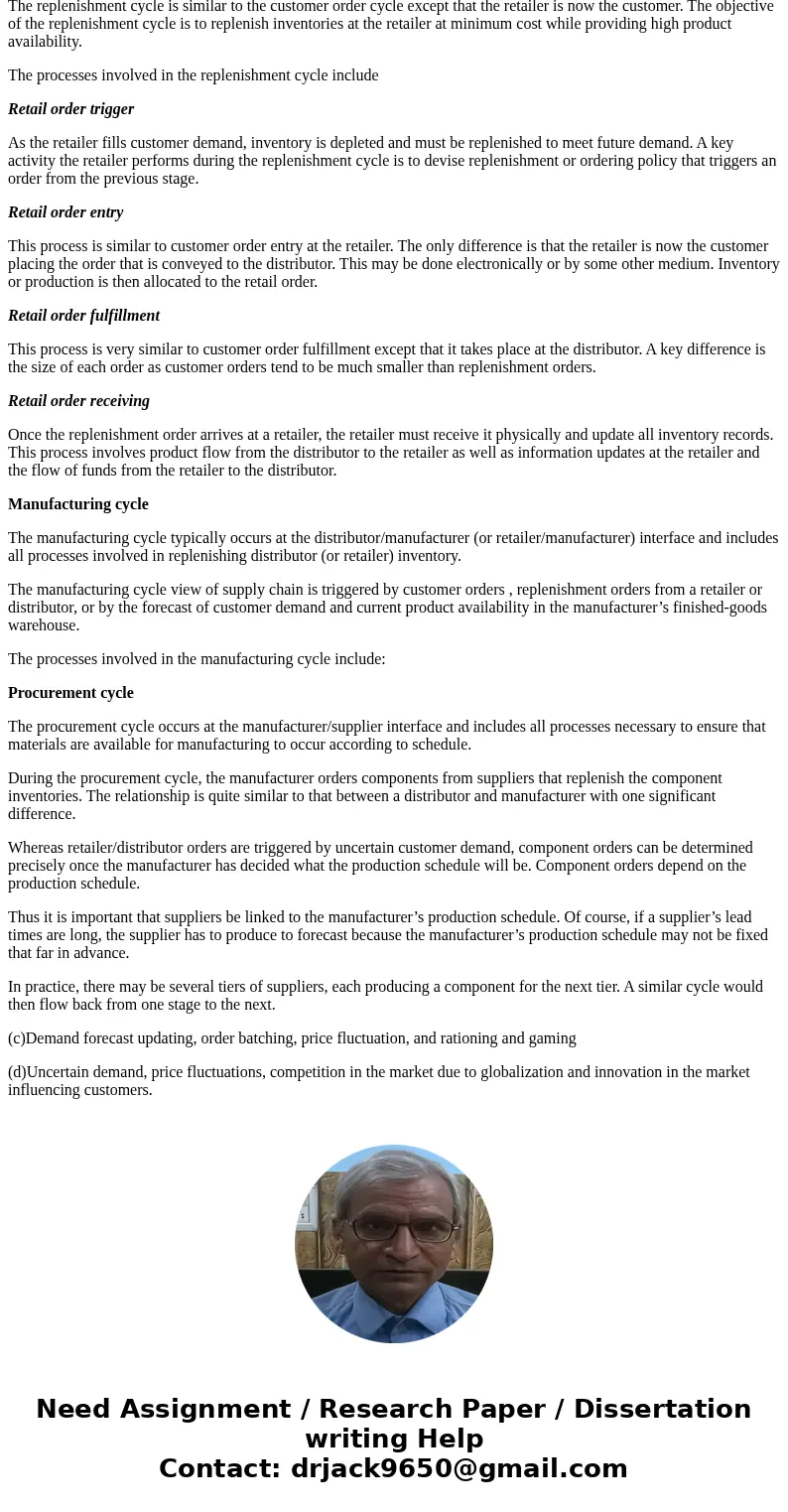Among those drivers of supply chain performance which one ca
Solution
(a)INFORMATION
It is a very useful commodity because it can be applied directly to enhance the performance of the other supply chain drivers. High levels of responsiveness can be achieved when companies collect and share accurate and timely data generated by the operations of the other drivers.
Thus, Information plays a vital role in improving supply chain efficiency and responsibility
(bb)The processes in a supply chain are divided into a series of cycles,
All supply chain processes can be broken down into the following four process cycles:
Each cycle occurs at the interface between two successive stages of the supply chain. Not every supply chain will have all four cycles separated.
For example, a grocery supply chain in which a retailer stock finished goods inventories and places replenishment orders, which a distributor is likely to have all four cycles separated.
A cycle view of a supply chain is very useful when considering operational decisions because it clearly specifies the rules and responsibilities of each member of the supply chain. The detailed process description of a supply chain in the cycle view forces a supply chain designer to consider the infrastructure required to support these processes.
Customer order cycle
The customer order cycle occurs at the customer/retailer interface and includes all processes directly involved in receiving and filling the customer’s order.
Typically, the customer initiates this cycle at a retailer site and the cycle primarily involves filling customer demand. The retailer’s interaction with the customer starts when the customer arrives or contact is initiated and ends when the customer receives the order.
The processes involved in the customer order cycle include:
Customer arrival
The term “customer arrival” refers to the customer’s arrival at the location where he or she has access to his or her choice sand makes a decision regarding a purchase. The starting point for any supply chain is the arrival of a customer.
From the supply chain perspective, the key flow in this process is the customer’s arrival. The goal is to facilitate the contact between the customer and the appropriate product so that the customer’s arrival turns into a customer order.
At a supermarket, facilitating a customer order may involve managing customer flows and product displays. At a telemarketing center, it may mean ensuring that customer does not have to wait on hold for too long.
It may also mean having systems in place so that sales representatives can answer customer queries in a way that turns calls into orders. At a website, a key system may be searched capabilities with tools such as personalization that allow customers to quickly locate and view products that interest them.
Customer order entry
The term “customer order entry” refers to customers informing the retailer what products they want to purchase and the retailer allocating products to customers. At a supermarket, order entry may take the form of customers loading all items that they intend to purchase onto their carts.
At a mail order firm’s telemarketing center or website, order entry involves customers informing the retailer of the items and quantities they selected.
Customer order fulfillment
During this process, the customer’s order is filled and sent to the customer. At a supermarket, the customer performs this process. At a mail order firm this process includes picking the order from inventory, packaging it, and shipping it to the customer.
All inventories will need to be updated, which may result in the initiation of the replenishment cycle. In general, customer order fulfillment takes place from retailer inventory. In a build-to-order scenario, however, order fulfillment takes place directly from the manufacturer’s production line.
Customer order receiving
During this process, the customer receives the order and takes ownership. Records of this receipt are updated and payment completed. At a supermarket, receiving occurs at the checkout counter. For a mail order firm, receiving occurs when the product is delivered to the customer.
Replenishment cycle
The replenishment cycle occurs at the retailer/distributor interface and includes all processes involved in replenishing retailer inventory. It is initiated when a retailer places an order to replenish inventories to meet future demand.
A replenishment cycle may be triggered at a supermarket that is running out of stock of detergent or at a mail order firm that is low in stock of a particular shirt.
The replenishment cycle is similar to the customer order cycle except that the retailer is now the customer. The objective of the replenishment cycle is to replenish inventories at the retailer at minimum cost while providing high product availability.
The processes involved in the replenishment cycle include
Retail order trigger
As the retailer fills customer demand, inventory is depleted and must be replenished to meet future demand. A key activity the retailer performs during the replenishment cycle is to devise replenishment or ordering policy that triggers an order from the previous stage.
Retail order entry
This process is similar to customer order entry at the retailer. The only difference is that the retailer is now the customer placing the order that is conveyed to the distributor. This may be done electronically or by some other medium. Inventory or production is then allocated to the retail order.
Retail order fulfillment
This process is very similar to customer order fulfillment except that it takes place at the distributor. A key difference is the size of each order as customer orders tend to be much smaller than replenishment orders.
Retail order receiving
Once the replenishment order arrives at a retailer, the retailer must receive it physically and update all inventory records. This process involves product flow from the distributor to the retailer as well as information updates at the retailer and the flow of funds from the retailer to the distributor.
Manufacturing cycle
The manufacturing cycle typically occurs at the distributor/manufacturer (or retailer/manufacturer) interface and includes all processes involved in replenishing distributor (or retailer) inventory.
The manufacturing cycle view of supply chain is triggered by customer orders , replenishment orders from a retailer or distributor, or by the forecast of customer demand and current product availability in the manufacturer’s finished-goods warehouse.
The processes involved in the manufacturing cycle include:
Procurement cycle
The procurement cycle occurs at the manufacturer/supplier interface and includes all processes necessary to ensure that materials are available for manufacturing to occur according to schedule.
During the procurement cycle, the manufacturer orders components from suppliers that replenish the component inventories. The relationship is quite similar to that between a distributor and manufacturer with one significant difference.
Whereas retailer/distributor orders are triggered by uncertain customer demand, component orders can be determined precisely once the manufacturer has decided what the production schedule will be. Component orders depend on the production schedule.
Thus it is important that suppliers be linked to the manufacturer’s production schedule. Of course, if a supplier’s lead times are long, the supplier has to produce to forecast because the manufacturer’s production schedule may not be fixed that far in advance.
In practice, there may be several tiers of suppliers, each producing a component for the next tier. A similar cycle would then flow back from one stage to the next.
(c)Demand forecast updating, order batching, price fluctuation, and rationing and gaming
(d)Uncertain demand, price fluctuations, competition in the market due to globalization and innovation in the market influencing customers.



 Homework Sourse
Homework Sourse